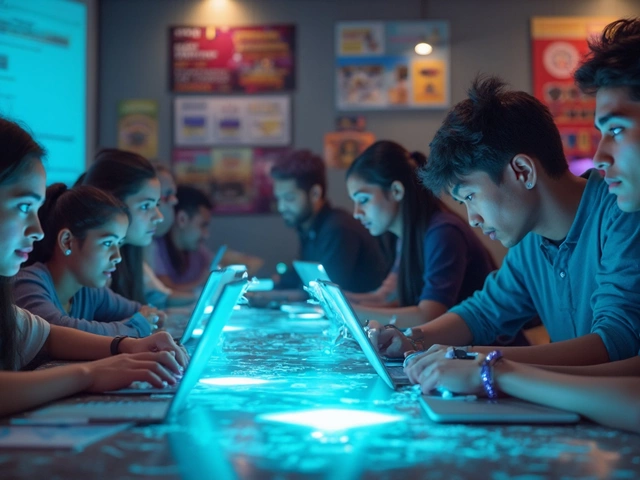As technology continues to evolve, the realm of education is experiencing a digital transformation, bringing about the rise of eLearning. This modern approach to learning provides flexibility and accessibility, allowing individuals to engage with educational content at their own pace.
With a multitude of platforms and formats now available, eLearning caters to a diverse range of learning preferences. Whether through video lectures, interactive assignments, or real-time discussions, digital learning environments are designed to enhance understanding and engagement. In this article, we delve into the world of eLearning, exploring its various examples and offering practical advice for making the most out of this educational format.
- The Evolution of eLearning
- Interactive Online Courses
- Virtual Classrooms and Learning Environments
- The Role of Gamification in eLearning
- Tips for Successful eLearning Experiences
The Evolution of eLearning
The concept of eLearning surfaced with the dawn of the internet, forever altering traditional education paradigms. Its roots can be traced back to the 1960s with the development of computer-based training (CBT) programs. These early systems offered a glimpse into the potential of digital learning, though they were limited by technology of the time. However, the real explosion of eLearning occurred with the proliferation of the World Wide Web in the mid-1990s, providing a fertile ground for the evolution of more sophisticated and interactive platforms. By the early 2000s, educational institutions started to recognize the significant impact of online education, leading to the creation of comprehensive digital courses and the emergence of platforms like Moodle and Blackboard, which offered a structured way for educators to present content to students worldwide.
As we moved further into the 21st century, the capabilities of online education expanded exponentially. With advancements in internet speed and the integration of multimedia, eLearning embraced new technologies such as video lectures, real-time webinars, and interactive simulations. This not only enhanced the quality of content delivery but also made learning more engaging for students. The rise of smartphones and tablets further facilitated learning on the go, ensuring that education was no longer confined to a traditional classroom setting. This unparalleled convenience attracted learners from all walks of life, from working professionals seeking further education to hobbyists exploring new interests.
In recent years, eLearning has integrated cutting-edge technologies such as artificial intelligence and machine learning, empowering platforms to offer personalized learning experiences tailored to individual needs. AI can analyze learner behavior and suggest resources or content that aligns with their interests and skill level, boosting motivation and engagement. This data-driven approach ensures that learners are neither overwhelmed nor under-challenged, offering a balanced learning journey. The impact of such developments is echoed in a statement by Dr. Tony Bates, an expert in distance education who remarked,
"The ability to adapt content to meet diverse learner needs marks a new era in personalized education, one that holds the promise of inclusive access to knowledge for all."
Moreover, the societal acceptance of digital courses has been bolstered by global events. The COVID-19 pandemic, for instance, forced many educational institutions to shift to remote learning almost overnight. This urgent transition underscored the viability and effectiveness of eLearning as a mainstream educational tool. A recent study conducted by the National Center for Education Statistics (NCES) found that over 35% of higher education students were enrolled in some form of eLearning in 2023, showcasing dramatic growth. The pandemic not only accelerated existing trends but also brought about innovations that addressed challenges of scalability, content delivery, and learner engagement.
Today, the landscape of eLearning platforms is vast and varied. From platforms offering Massive Open Online Courses (MOOCs), such as Coursera and edX, to more niche and specialized offerings like LinkedIn Learning and Skillshare, individuals have access to a plethora of options tailored to specific needs and interests. Whether it's mastering a new language, learning to code, or understanding complex scientific theories, eLearning has democratized education, breaking geographical and financial barriers that previously limited access. As we look to the future, the evolution of eLearning seems poised to continue its trajectory of growth and innovation, with potential developments in virtual reality and augmented reality promising to make learning even more immersive and interactive.
Interactive Online Courses
Interactive online courses have become a cornerstone of the eLearning landscape, providing a dynamic approach that engages learners beyond traditional methods. These courses stand out for their ability to incorporate multimedia elements such as videos, quizzes, and discussion forums which cater to diverse learning styles. A notable characteristic is the increased engagement they inspire through these interactive components, making education more immersive and enjoyable. Research has shown that learning retention rates increase significantly when interactive features are present in courses. For instance, the use of gamification, which introduces game-like elements, is a popular strategy that enhances motivation and involvement. This method not only makes learning more entertaining but also aids in maintaining a learner's focus and interest throughout the course.
One famous example of interactive online courses can be found on platforms like Coursera and Udemy, which offer a wide range of subjects, from computer science to creative writing. These platforms allow learners to interact with content in innovative ways, such as coding exercises that provide instant feedback, or peer-reviewed assignments that foster community learning. In a study by Inside Higher Ed, it was noted that students learn better in environments where they can control the pace of their learning and receive immediate results from their activities. This is especially beneficial for those who may require more time to grasp complex topics or prefer quick pivots through simpler subjects. Such flexibility ensures that education is accessible to everyone, regardless of their geographic location or personal schedules.
The importance of interaction in these courses cannot be overstated. What sets them apart is how they manage to create a sense of community amongst learners even though they may be thousands of miles apart. Through real-time discussions, collaborative projects, and mentorship opportunities, students can engage with peers and instructors, fostering a collaborative environment that mirrors traditional classroom dynamics. Live webinars and Q&A sessions often allow for direct interaction, helping clarify doubts and solidify understanding. But it's not just about simulating a classroom atmosphere; interactive online courses also leverage analytics to adapt the learning experience to student performance and preferences, often using AI to refine curriculum offerings.
The flexibility and inclusivity of interactive online courses extend their appeal to a varied audience, appealing not only to students but also to professionals seeking to upgrade their skills. In fact, many employers are starting to recognize the value of these online certificates, which can equate to practical experience in a given field. The convenience of accessing these courses through multiple devices, including smartphones and tablets, has only added to their accessibility. As such, they've bridged a gap for those who cannot attend traditional classes due to work commitments or personal responsibilities, providing high-quality education wherever and whenever it's needed.
"Interactivity in online courses is not just an add-on; it’s a critical component for effective digital education," says Dr. John Whitmore, a leading expert in online learning methodologies.
Looking ahead, the future of interactive online courses seems promising as technology continues to advance. The integration of virtual reality and augmented reality is set to make these courses even more immersive, providing experiences that were once imaginable only in sci-fi novels. Imagine walking through historical sites or diving into the molecular world in a chemistry class, all from the comfort of your living room. With the ability to create such vivid and engaging environments, the boundary between physical and online learning is blurring, offering limitless educational possibilities.

Virtual Classrooms and Learning Environments
The emergence of online education has introduced the concept of virtual classrooms, reshaping the traditional notion of a learning space. These digital environments have become an invaluable component of eLearning platforms, offering a dynamic and interactive experience that mimics and often enhances, the physical classroom setting. With virtual classrooms, it doesn't matter where you are; what matters is that you are connected, ready to engage with peers and educators from across the globe. Using a combination of video conferencing, chat features, and digital whiteboards, learners are provided with the tools necessary to facilitate discussions, collaborate on projects, and receive real-time feedback from their instructors.
One of the prominent benefits of virtual classrooms is their ability to foster a sense of community and belonging among learners, which is crucial for educational success. This is achieved by recreating the social aspects of learning, despite the geographical barriers. For instance, platforms like Zoom and Microsoft Teams have become household names, widely utilized by institutions and businesses alike to maintain continuity in education and training. "The ability to collaborate and feel part of a community, no matter the physical location, is what makes virtual classrooms a game-changer in modern education," opines Trevor Leinkauf from The EdTech Studio. With screen-sharing features and break-out room functionalities, students can work together in smaller groups, ensuring participation is active rather than passive.
The versatility of these digital courses can cater to different learning styles. Whether a student learns best through listening, watching, or hands-on activities, virtual classrooms have something to offer. Educators can present material through interactive slideshows, video demonstrations, or real-time simulations, ensuring that all students can comprehend and retain information effectively. This adaptability is evident in higher education, where universities are integrating virtual laboratories into their curriculums, allowing students to conduct real-world experiments virtually, thus bridging gaps in experiential learning.
However, creating an effective virtual classroom goes beyond just technological tools; it involves a shift in teaching strategies and a focus on designing engaging and inclusive courses. Course facilitators are now adopting innovative practices such as flipping the classroom, where students first absorb information individually and later engage in interactive sessions to apply knowledge practically. This method encourages critical thinking and problem-solving—skills highly sought after in today's job market.
Despite the advantages, virtual learning environments are not without challenges. Not every student has equal access to high-speed internet or digital devices, highlighting the digital divide that exists in many parts of the world. Educational institutions and policy-makers are tasked with addressing these gaps to ensure equitable access to quality education for all. Meanwhile, integrating AI and adaptive learning technologies holds promise for the future, with systems capable of personalizing the learning experience based on individual learner needs and capabilities.
To fully understand the impact and potential of virtual classrooms, let's examine a few key data points that illustrate their growth and reach. In a recent study, it was found that 72% of the education industry had adopted virtual classrooms at some level by 2023, showcasing a steady increase in acceptance and recognition of its benefits. Such statistics emphasize the pivotal role virtual learning environments play in the evolving landscape of education, marking a move towards more accessible and flexible learning solutions.
The Role of Gamification in eLearning
In recent years, gamification has carved out a significant niche in the landscape of eLearning, infusing educational content with elements traditionally found in games. This trend leverages the human predisposition for play, making learning activities not only engaging but also deeply motivating. It's no secret that gamification transforms mundane lessons into compelling adventures, where badges, leaderboards, and progress bars inspire learners to complete assignments and improve their skills. The concept is rooted in the psychological principle that challenge and reward can significantly boost motivation and retention.
One interesting fact is that the brain releases dopamine when we're rewarded, which explains why learners are more likely to retain information through gamified processes. For instance, a well-designed digital course might simulate a quest where gaining knowledge equates to advancing levels or earning points, which are inherently motivating. According to a study by the University of Colorado, college students who engaged with gamified content scored 14% higher in skill-based assessments and showed 11% higher factual knowledge retention compared to their counterparts without game-based elements. This aligns with the theory that learning through play encourages deep cognitive engagement.
An illustrative example of gamification in action is Duolingo, an online language learning platform. It incorporates competitive and fun game-like features to encourage regular practice. Users are incentivized with lingots (Duolingo’s virtual currency) and streak counts to maintain consistent learning habits. This not only increases the duration users spend on the platform but also significantly enhances the effectiveness of the learning experience. Gamification isn't limited to language apps; platforms like Kahoot! and Quizlet employ similar strategies across a variety of subjects.
"Games are the most elevated form of investigation," said the renowned thinker Albert Einstein, whose assertion reflects our innate curiosity and attraction to gamified scenarios.
It's crucial, however, for educators and developers who implement gamification in eLearning to carefully balance game mechanics with educational content to avoid trivializing the material. They should clearly define learning objectives and ensure that they align with the game's goals to maintain educational integrity. This balance ensures that the primary focus remains on learning, not just on earning virtual rewards. Data analytics can further assist in tracking progress and providing feedback, essential components in a successful eLearning environment. Students, too, should be mindful of the intrinsic motivation that comes from personal growth, ensuring that game mechanics simply serve as a catalyst rather than the sole driver of their educational journey.
For those considering gamification, it's worth starting with small, scalable elements and gradually expanding as you witness what resonates with learners. Keeping an eye on feedback and engagement metrics is vital to refining the system to better meet learners' needs. By adopting such practices, educators can create an enriched learning experience that holds learners' attention and enhances their educational journey. So whether you're exploring online education as a learner or an educator, gamification can be a powerful tool in making learning captivating and effective—one game level at a time.

Tips for Successful eLearning Experiences
Diving into the world of eLearning can be both liberating and daunting. On one hand, learners are given the autonomy to manage their own schedules, diving into courses from any location with internet access. On the other hand, this flexibility requires discipline, planning, and the right mindset. Successfully navigating the waters of online education necessitates an approach that blends structure with creativity. To make sure you get the most out of your online education, consider implementing several key strategies that are both practical and proven effective by countless learners before you.
First, establishing a dedicated learning space is crucial. It's tempting to study from the comfort of your bed, but creating a specific spot—it could be a corner in your room or a bare desk—can have a significant psychological impact on productivity. This space doesn't have to mirror a traditional classroom from floor to ceiling but should be free from distractions, with all necessary materials within arm's reach. Alongside creating a learning-friendly environment, setting up a consistent study schedule helps in forming a routine. You might take advantage of digital tools like calendars or apps that set reminders and block out specific study times, incorporating short breaks to recharge your mind.
Active Engagement in eLearning
Engagement is at the very heart of effective learning. Passive reading is okay in bits, but real understanding and retention come from being active in the process. Embrace the interactive elements provided by learning platforms. Participating in forums, engaging in peer discussions, and taking part in interactive quizzes can elevate your learning experience. When platforms offer live sessions, don’t shy away from attending; these mimic the classroom environment and offer an opportunity to ask questions then and there. The famous educator John Dewey once said,
"Education is not preparation for life; education is life itself."His words underline the importance of remaining present and involved during any learning process.
Leveraging Available Resources
eLearning programs are often bundled with a myriad of resources that go beyond just video lectures. Tapping into these materials provides leverage in mastering a subject. Look for supplementary readings, assignment guides, and recorded webinars that can often shed light on complex topics. For those who incline towards auditory learning, podcasts and audiobooks could be invaluable. Visual learners, conversely, might appreciate looking at infographics or concept maps. Depending on the eLearning platform, you can even find communities or groups focused on specific subjects, offering opportunities to network, exchange ideas, or even provide tutoring to your peers, which is a fantastic way to reinforce your understanding.
Lastly, the onus is also on you to self-reflect and self-assess. Regularly take a step back and evaluate your progress. Are you achieving the learning goals you've set for yourself? Non-graded assessments or open book quizzes can be a great way to measure your understanding. If you stumble across problems, don't hesitate to reach out for help; most platforms have support or mentoring options available. This proactive process not only identifies areas that need improvement but also reinforces areas you feel confident in. With determination, an effective strategy, and leveraging the tools at your disposal, the eLearning journey can be as rewarding and enlightening as the traditional learning paths of the past.





